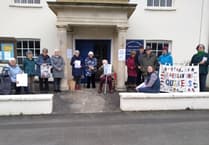A PRINT by the late Michael Blackmore currently on display in Martin’s Framing and Gallery is to be auctioned for charity.
The print donated by Michael’s friend, local man Mike Reed, is an illustration of the Abergavenny to Govilon Turnpike road as it was in 1809.
Mike, who lives in the area where the old road once passed through, explained, “I had always been a long-time admirer of Michael’s paintings, and thought he was extremely gifted and talented.
“I can still recall the first time I met him. He was sitting near the fields at Pen-y-Worlod Farm, sketching the River Usk with Abergavenny Town and Castle in the background. I struck up a conversation and it was the beginning of a long friendship.”
Over time, Michael and Mike shared many a cup of coffee at the latter’s farm, where the two of them studied Mike’s old maps of the Llanfoist area.
Mike told the Chronicle, “Michael often referred to the maps as preparation for his illustrations. I was very much aware on these occasions I was in the company of a great artist.”
Michael had already completed a contemporary painting of the Turnpike Bridge prior to its recent restoration to listing standard. The original picture now proudly hangs in Mike’s house.
Mike explained, “I was so impressed with the painting I asked Michael if he would do an illustration of the Turnpike Bridge, my house (Pen-y-Worlod) and the Toll House in its 1809 heyday.
Michael accepted the commission but the only downside was Mike had to wait two years for the finished item because of Michael’s busy diary and constant demand for his work.
Mike said, “When I eventually saw the painting it exceeded all my expectations. It was to my mind of an unbelievable standard. The sheer amount of detail in it took my breath away.”
As a keen student of local history, Mike was particularly pleased with the painting because he felt it authentically captured exactly how the area which he calls home would have once looked many moons ago.
During the time of the A465 dueling development Mike had a section of his land encroached upon by work taking place on the heads of the valley road.
Significantly, the loss of land entailed that a sixteenth century gentlemen’s bridge originally built for the Price family of Ty-Mawr had to be taken down.
Mike told the Chronicle, “Archaeologist Adam Stanford oversaw and recorded the deconstruction of the stone slab bridge, and as I felt strongly about preserving its heritage, I made a written request to the Welsh assembly government to use the materials of the bridge and rebuild it downstream. “
Although his request was granted, he discovered that he was not in the financial position to undertake the necessary work involved.
However, Mike felt that if the materials of the gentlemen’s bridge could be used in restoring the stone arch turnpike bridge, then it would not be a total loss.
Mike said, “The gentlemen’s bridge over which there was a pedestrian foot path, was mainly used for all heavy loads for Pen-y-Worlod farm. The bridge was used in preference due to its sound condition, whereas the old turnpike bridge was unsound with decking worn through to stone arches and it had parapets missing.”
At that time Mike believed the removal of the gentlemen’s bridge would be detrimental to the remaining unsound turnpike bridge, because it would have double the workload that was undertaken by the sound bridge, and his main concern was that both bridges would be lost to the abyss of history if he failed to act.
Mike told the Chronicle, “Prior to the Industrial Revolution there was only one road West of Abergavenny to Govilon, which was then known as the Tudor Road.
“Named after Jasper Tudor, that road begins at Lanfoist’s Tudor Bridge and was probably initially a Roman road leading to a Roman fort in a field just West of Pen-y-Worlod Farm. The fort was identified by archaeologist George Nash during the dualling of the A465.
“The Romans would probably have had an interest in the iron ore on the Blorenge Mountain which was probably mined from the Iron Age. Hence Govilon being known as ‘the village of the smiths.’”
Mike (pictured right) added, “The Tudor Road was ideal to transport freight to the Canal at Govilon so it became a Turnpike Road
“The freight then travelled via the canal and tram rail to Blaenavon and Clydach iron works. The turnpike road only ceased to be used when the Llanvihangel Crucorney tram road opened in 1814.
“Following that there was no real need for the Pen-y-Worlod Turnpike Road which also ceased to be used as a roadway.
“However, the turnpike bridge features prominently in the changes of transport through history and is very much one of the foundation stones of the industrial revolution that transformed this area.”
After years of careful work the bridge was once again restored to its former glory.
The process was solely financed by Mike and during the restoration only local tradesman using local materials were involved.
A Cadw spokesperson said upon completion of the work, “I think it is admirable Mr Reed has taken so much time and effort to rebuild this structure. It has been transformed from a ruinous structure, which would otherwise have collapsed before long, into a well-constructed bridge that will last for a considerable time.”
Although fully restored, it is still hard to visualize the bridge and the area as it would have appeared in the nineteenth century. For that reason Mike is eternally grateful for Michael Blackmore’s atmospheric painting.
Mike explained, “To my mind this is equal, if not better than a piece by the likes of Constable. It fully evokes the past in all its colour and glory, and is a very engaging slice of local history.
“I’d now like to thank Michael for his commitment and all his hard work by auctioning a print of the painting for charity.
“We are holding an open tender auction at Martin’s Framing and Gallery in Abergavenny. Interested parties can pop in, make a bid, and leave their telephone number and address. All proceeds will go to St David’s Foundation Care. Good luck.”




